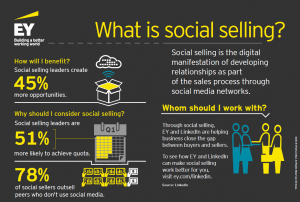DIGITAL SELLING INTRODUCTION
Digital selling is the process of leveraging digital assets (white papers, research, articles, news, offers etc) and communicating to attract customers through digital channels to build trust and credibility. Digital selling is an multi channel method that may include social media as well as other digital channels such as video, email, text, online forums etc to ultimately generate leads and referrals. So, any digital communication to engage buyers is digital selling.
Social selling is an essential component of digital selling and refers to when salespeople use social networks to find, engage and connect with prospects to start conversations and build relationships. Both terms include the word “selling,” but in reality, we do not sell on digital. People respond negatively to sales pitches through digital channels. Both terms refer to a process of connecting and engaging to start more sales conversations with qualified buyers.
According to an EY study, companies that utilize digital selling techniques are 5.7 times more likely to secure prospect meetings and hit 150 percent of their quotas on average.
So, Digital selling covers a number of sales activities to build awareness, credibility, and attract buyer interest using personal brand promotion, real world networking, social media networks and digital channels. Digital Selling is the act of infusing engagement and conversations into the traditional sales process in order to expand the reach to prospects and customers. To streamline how as salespeople we develop, advance, and maintain relationships with people.
Digital Selling is the next step forward making the sales process more productive and meaningful.
Digital selling helps increase revenue in three keyways. It:
• Creates a bigger pipeline with more leads. A large insurance digitally enabled sales reps generated twice as many sales opportunities as its traditional sales reps.
• Converts more leads to sales. A credit card company increased its lead-to-close conversion rate by 25% through digital selling.
• Boosts the average deal size. A world leader in internet security software saw a 64% increase in average deal size after adopting digital selling.
It helps reduce costs by enabling sales to spend:
• Less time finding the right contacts in their market or area. Sales reps who actively use digital selling capabilities are 2.7 times more likely to identify the best path into a potential client.
• Less time on non-productive activities. Sales reps who use digital selling are 5.7 times more likely to secure meetings
Digital Selling introduction sales training can enable a salesperson to excel in six key areas:
• Identifying leads, profiles, and decision makers
• Leverage information or insights to build relationships
• Create “sales conversations” across multiple channels
• Deliver a consistent, enriching personalized experience
• Boost the salespersons “digital sales confidence”
• Increased level of connectivity and influence with people
Identify leads, prospects, and decision makers more effectively with social networking. Social networks are now a force to be reckoned with. LinkedIn, for instance, has over 500 million members, and Facebook has about 2 billion monthly active users. They’re also a veritable goldmine of valuable insights that can help sales better understand customers and their agendas. They can reveal key information, including customers’ employment history, jobs and roles, relationships with others, education, interests and even vendor preferences.
Salespeople also can use social networks and their insights to shorten “time to trust” by leveraging common interests, experiences, and connections; establish, plus foster, and maintain trusted relationships at scale; and engage with buyers much earlier in the decision-making process.

Social networks can significantly enhance a salespersons performance. For instance, research proves that those salespeople who leverage social networks to help build and nurture relationships with prospects and customers — are viewed as highly effective and are widely seen as high-performing salespeople. In fact, salespeople who excel at digital selling create more opportunities and are 51% more likely to hit their sales targets.
Boost a salespersons “digital sales confidence” by integrating digital capabilities into current sales activities to understand a customer’s needs, wants or agenda and most effectively position the company’s offerings. Digital selling requires some new ways of working and that can be a change for a salesperson used to the “tried and true.”
For instance, gone are the days when only cold calls, referrals, and email is used to identify prospects and spark sales conversations. Traditional ways of developing relationships — such as face-to-face meetings, video calls, events and dinners, gifts, and promotional marketing collaterals will live on but will be complimented by wholly new digital relationship building capabilities.
These new ways of selling include prospecting focuses on “pull” versus “push”; warm introductions via contacts, connecting with friends, school/university classmates, ex-work colleagues, etc; and social hours (vs. call hours). And salespeople will benefit from having hundreds of millions of searchable prospects on social networks at their disposal as well as the ‘collective network’, the aggregation of all companies employees contacts which can be shared and tapped for introductions to potential customers.
Similarly, relationships will be fostered through a deep understanding and advancement of a customer’s agenda via such things as sharing news, information and high-value content, engagement in digital communities, and the execution of other “digital gracious acts” or online favor that people appreciate and value. Developing trust quickly and consistently measuring trust over time will be critical to sustaining long-term relationships. The fact is, selling is evolving rapidly to encompass a blend of traditional and digital channels, as well as a mix of real life human and online social interactions. With customers increasingly educating themselves online and interacting via digital channels. The most effective salespeople are those who can make the transition to consultative sellers: digitally savvy guides who make themselves indispensable by deeply understanding customers’ needs and providing solutions that meet them.
“The sales force is transforming from hagglers into consultants,” More and more companies need salespeople who have the ability to sell solutions in a digital environment.” To be sure, it’s a big change. That’s why now is the time to make the transformation where digital selling combined with traditional sales approaches will be second nature.
The Top 4 Reasons Why Salespeople Use Digital Selling
1. Traditional sales tactics have become harder
2. Buyers are open to networking online
3. Extends influence and lead generation potential
4. Build a bigger network of prospects and connections
Digital Selling Introduction consists of five main steps:
1. Establishing a presence on social networks to complement existing sales tactics
2. Finding the right people (Research into Ideal Customer Profiles)
3. Engaging with those people online/offline (Content, Scripts, Engagement)
4. Building trust (Credibility and Connecting)
5. Measuring the impact (Meetings, Referrals, Leads and Revenue)
The 6C’s of Digital Selling
1. Credibility to highlight expertise and skills.
2. Connecting to prospects and existing customers.
3. Content including sales scripts, offers, promotions etc.
4. Conversations that generate interest for meetings/calls.
5. Conversions to pipeline opportunities.
6. Consistency in your activity to drive referrals and exposure.
Digital Selling does not replace Sales
Digital selling is not a substitute for real selling. The person to person sales interactions will have to happen but how or when they happen needs to be planned. Conversations with buyers have to be happening both offline and online and then moved offline into the sales process. If there is no offline conversation happening, then you are doing social marketing.
“Rather than focus digital selling efforts on ‘contacting more’ or ‘contacting faster,’ a more effective method is to think of digital selling first as a path to improved lead generation and engagement
Digital selling is an additive process. This is not a replacement for phone calls and prospecting emails. It is an additive approach, a prescriptive process like another arrow in the quiver that you should think about, “How do I apply digital selling to all sales activity, every prospect, every deal, every single day.
The first step to becoming effective at Digital Selling is to understand that it’s a complement to traditional sales methods, not a revolutionary approach that replaces them. At the end of the day, it is still about connecting people to people, and people to information. Digital selling, due to its ability to enhance the customer journey, is an incredibly powerful sales tool. But, like any tool, its value and utility are ultimately tied to the skills of the individual employing it.
Digital Selling introduction builds on the principle – All selling is social. Always has been. Always will be.
Before Facebook, before LinkedIn, before the web in fact, people bought from people in social ways. They asked for advice from friends, they gave their opinions over coffee, and they wrote “satisfied or dissatisfied customer” letters to companies using pen and paper.
In a nutshell, digital selling is the process of combining traditional sales tactics with channels like Facebook, Twitter, and LinkedIn to:
1. Build relationships – BE SEEN
2. Credible personal reputation – BE FOUND
3. Get visibility with your target market – BE USEFUL
4. Deliver value to your target market – BE VALUABLE
5. Build trust as a valuable connection – BE REAL
The more active, present, believable, and visible a salesperson is, the more relationships they will build. Digital Selling training is just one of The Digital Sales Institute online courses
Source: Digital Selling Introduction – The Digital Sales Institute







